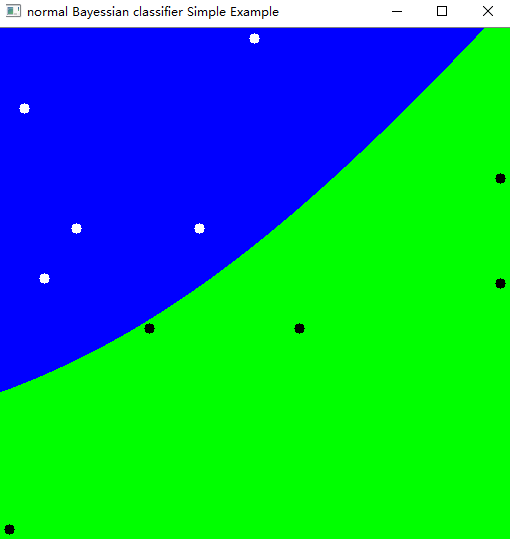opencv3.0版本中,实现正态贝叶斯分类器(Normal Bayes Classifier)分类实例
#include "stdafx.h" #include "opencv2/opencv.hpp" using namespace cv; using namespace cv::ml; int main(int, char**) { int width = 512, height = 512; Mat image = Mat::zeros(height, width, CV_8UC3); //创建窗口可视化 // 设置训练数据 int labels[10] = { 1, -1, 1, 1,-1,1,-1,1,-1,-1 }; Mat labelsMat(10, 1, CV_32SC1, labels); float trainingData[10][2] = { { 501, 150 }, { 255, 10 }, { 501, 255 }, { 10, 501 }, { 25, 80 }, { 150, 300 }, { 77, 200 } , { 300, 300 } , { 45, 250 } , { 200, 200 } }; Mat trainingDataMat(10, 2, CV_32FC1, trainingData); // 创建贝叶斯分类器 Ptr<NormalBayesClassifier> model=NormalBayesClassifier::create(); // 设置训练数据 Ptr<TrainData> tData =TrainData::create(trainingDataMat, ROW_SAMPLE, labelsMat); //训练分类器 model->train(tData); Vec3b green(0, 255, 0), blue(255, 0, 0); // Show the decision regions given by the SVM for (int i = 0; i < image.rows; ++i) for (int j = 0; j < image.cols; ++j) { Mat sampleMat = (Mat_<float>(1, 2) << j, i); //生成测试数据 float response = model->predict(sampleMat); //进行预测,返回1或-1 if (response == 1) image.at<Vec3b>(i, j) = green; else if (response == -1) image.at<Vec3b>(i, j) = blue; } // 显示训练数据 int thickness = -1; int lineType = 8; Scalar c1 = Scalar::all(0); //标记为1的显示成黑点 Scalar c2 = Scalar::all(255); //标记成-1的显示成白点 //绘图时,先宽后高,对应先列后行 for (int i = 0; i < labelsMat.rows; i++) { const float* v = trainingDataMat.ptr<float>(i); //取出每行的头指针 Point pt = Point((int)v[0], (int)v[1]); if (labels[i] == 1) circle(image, pt, 5, c1, thickness, lineType); else circle(image, pt, 5, c2, thickness, lineType); } imshow("normal Bayessian classifier Simple Example", image); // show it to the user waitKey(0); }

如果将数据换成是图片的像素值 ,则可实现图片的分类。